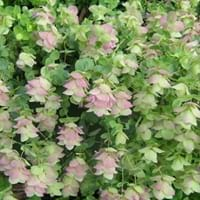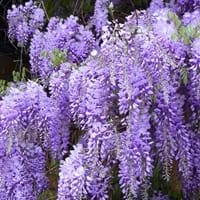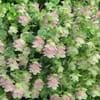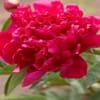Life Span
Perennial
Perennial
Type
Perennial
Flowering Plants
Origin
Hybrid origin
China, Eastern United States, Japan, Korea
Types
Kent Beauty
Amethyst Falls
Barbara Tingey
Chinese Wisteria, Japanese wisteria, Silky wisteria, American wisteria
Habitat
Grassland, Open scrub, Rocky areas
Forest edges, River side
USDA Hardiness Zone
5-8
5-9
Sunset Zone
Not Available
2a, 2b, 3a, 3b, 4, 5, 6, 7, 8, 9, 10, 11, 13, 14, 15, 16, 17, 18, 19, 20, 21, 22, 23, 24
Habit
Clump-Forming
Vine/Liana
Minimum Height
Not Available
Minimum Width
Not Available
Flower Color
Pink
Pink, Purple, Violet
Flower Color Modifier
Bicolor
Not Available
Fruit Color
Not Available
Not Available
Leaf Color in Spring
Dark Green
Green
Leaf Color in Summer
Dark Green
Green
Leaf Color in Fall
Dark Green
Green
Leaf Color in Winter
Light Green
Not Available
Plant Season
Summer, Fall
Spring
Sunlight
Full Sun
Full Sun
Type of Soil
Loam
Clay, Loamy, Sandy
The pH of Soil
Neutral, Alkaline
Neutral, Slightly Acidic, Slightly Alkaline
Soil Drainage
Well drained
Well drained
Bloom Time
Late Summer, Early Fall
Mid Spring
Tolerances
Drought
Not Available
Where to Plant?
Container, Ground, Pot
Ground, Pot
How to Plant?
Seedlings
Seedlings
Plant Maintenance
Medium
Medium
Watering Requirements
Allow soil to be completely dry in between waterings, Does not require lot of watering, Water twice a day in the initial period, Water when soil is dry
Water in morning to avoid prompting diseases, when new, water every week
In Summer
Lots of watering
Lots of watering
In Spring
Moderate
Moderate
In Winter
Average Water
Average Water
Soil pH
Neutral, Alkaline
Neutral, Slightly Acidic, Slightly Alkaline
Soil Type
Loam
Clay, Loamy, Sandy
Soil Drainage Capacity
Well drained
Well drained
Sun Exposure
Full Sun
Full Sun
Pruning
Remove damaged leaves, Remove dead branches, Remove dead leaves
Cut or pinch the stems, No pruning needed in the early stages, Prune twice a year, Remove dead or diseased plant parts, Remove deadheads
Fertilizers
All-Purpose Liquid Fertilizer
All-Purpose Liquid Fertilizer
Pests and Diseases
Red blotch
Aphids, Canker, Crown gall, Leaf spot, Mealybugs, Powdery mildew, Root rot, Scale
Plant Tolerance
Drought
Drought
Flower Petal Number
Single
Single
Fragrant Leaf
Not Available
No
Foliage Texture
Fine
Coarse
Foliage Sheen
Matte
Not Available
Attracts
Butterflies
Flying insects
Allergy
Not Available
Itchiness
Aesthetic Uses
Showy Purposes
Showy Purposes
Beauty Benefits
Not Available
Not Available
Environmental Uses
Air purification
Air purification
Medicinal Uses
Bloating, Bronchitis, Cough, Cramps, Croup, Gastrointestinal disorders, Headache, Rheumatoid arthritis, Urinary tract problems
Not Available
Part of Plant Used
Leaves
Flowers, Seeds
Other Uses
Employed in herbal medicine, Used As Food
Sometimes used for making wine
Used As Indoor Plant
Yes
No
Used As Outdoor Plant
Yes
Yes
Garden Design
Container, Edging, Groundcover, Mixed Border
Shady Tree, Showy Tree, Street Trees
Botanical Name
ORIGANUM 'Rose Dome'
Wisteria
Common Name
Ornamental Oregano
Wisteria
In Hindi
सजावटी अजवायन
Wisteria
In German
Ornamental Oregano
Glyzinien
In French
ornement origan
Glycines
In Spanish
Ornamentales orégano
Glicinas
In Greek
καλλωπιστικά Ρίγανη
γλυκίνη
In Portuguese
ornamental Oregano
Glicínias
In Polish
ozdobne Oregano
Wisteria
In Latin
decentius Oregano
Wisteria
Phylum
Not Available
Anthophyta
Class
Magnoliopsida
Dicotyledonae
Order
Not Available
Fabales
Family
Lamiaceae
Fabaceae
Clade
Angiosperms, Eudicots
Not Available
Tribe
Mentheae
Millettieae
Subfamily
Pitcairnioideae
Faboideae
Number of Species
Not Available
Season and Care of Ornamental Oregano and Wisteria
Season and care of Ornamental Oregano and Wisteria is important to know. While considering everything about Ornamental Oregano and Wisteria Care, growing season is an essential factor. Ornamental Oregano season is Summer and Fall and Wisteria season is Summer and Fall. The type of soil for Ornamental Oregano is Loam and for Wisteria is Clay, Loamy, Sandy while the PH of soil for Ornamental Oregano is Neutral, Alkaline and for Wisteria is Neutral, Slightly Acidic, Slightly Alkaline.
Ornamental Oregano and Wisteria Physical Information
Ornamental Oregano and Wisteria physical information is very important for comparison. Ornamental Oregano height is Not Available and width Not Available whereas Wisteria height is 10.00 cm and width 30.00 cm. The color specification of Ornamental Oregano and Wisteria are as follows:
Ornamental Oregano flower color: Pink
Ornamental Oregano leaf color: Dark Green
Wisteria flower color: Pink, Purple and Violet
- Wisteria leaf color: Green
Care of Ornamental Oregano and Wisteria
Care of Ornamental Oregano and Wisteria include pruning, fertilizers, watering etc. Ornamental Oregano pruning is done Remove damaged leaves, Remove dead branches and Remove dead leaves and Wisteria pruning is done Cut or pinch the stems, No pruning needed in the early stages, Prune twice a year, Remove dead or diseased plant parts and Remove deadheads. In summer Ornamental Oregano needs Lots of watering and in winter, it needs Average Water. Whereas, in summer Wisteria needs Lots of watering and in winter, it needs Average Water.





